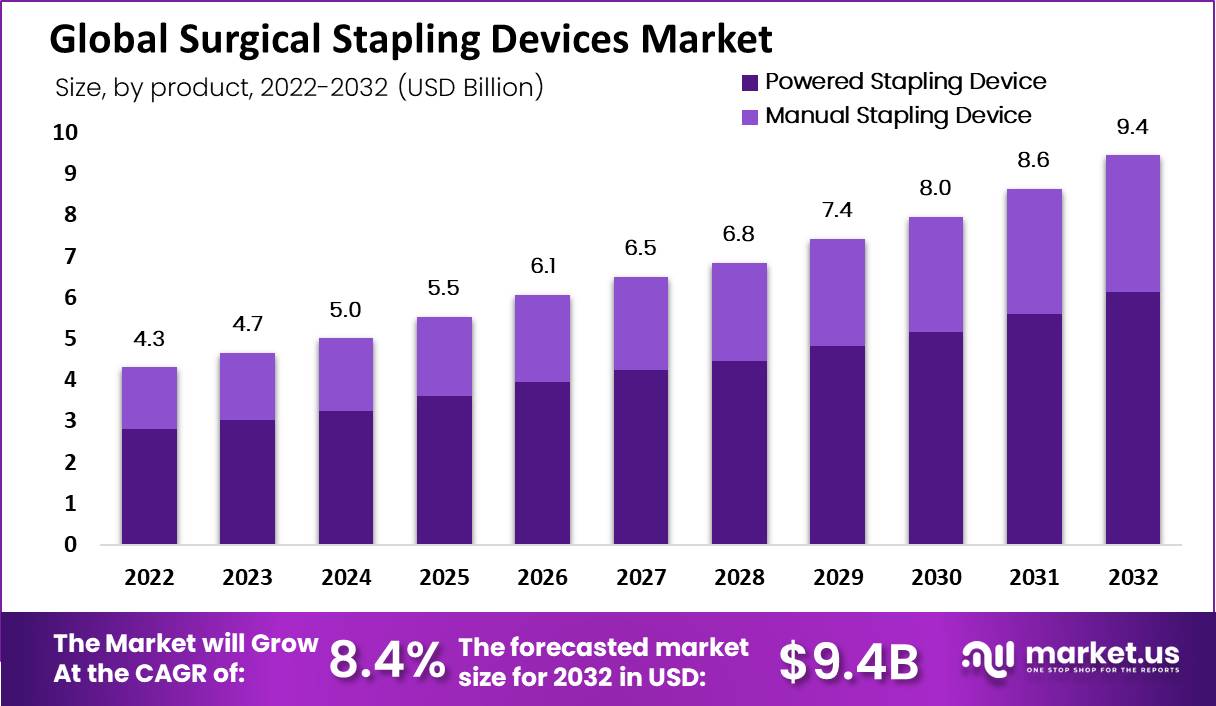Introduction
The surgical stapling devices market, valued at USD 4.3 billion in 2022, is anticipated to expand significantly, reaching USD 9.4 billion by 2032, with a projected compound annual growth rate (CAGR) of 8.4% from 2023 to 2032. This growth is primarily fueled by the demand for increased surgical precision and efficiency, especially in minimally invasive procedures. The continuous development of endoscopic and flexible staplers exemplifies this trend, facilitating improved access and accuracy in suturing within restricted anatomical regions, particularly in abdominal surgeries.
Technological advancements are further propelling the market forward. Modern stapling devices now feature enhancements such as multiple suture rows and staple-line reinforcement, which enhance tissue sealing and reduce the likelihood of postoperative complications like gapping or infections. The integration of materials like titanium in staples is noteworthy for its compatibility with MRI scanners and minimized immune responses, promoting patient safety during post-operative imaging procedures.
Another significant shift in the market is the increasing preference for disposable stapling devices over reusable ones. This trend is driven by heightened concerns regarding sterilization and the functional reliability of reusable devices. Opting for disposable staplers ensures that each patient is treated with a sterile device, thus minimizing the risks of cross-contamination and maintaining surgical integrity.
In conclusion, the surgical stapling devices sector is witnessing rapid evolution, characterized by significant technological breakthroughs that promise enhanced surgical outcomes. These innovations not only ensure greater procedural efficiency and precision but also prioritize patient safety and recovery. As technology advances, it is expected that new developments in stapling devices will continue to revolutionize surgical practices, further boosting market growth and improving healthcare delivery.

Key Takeaways
- The market was valued at USD 4.3 billion in 2022 and is forecast to expand at an 8.4% CAGR, reaching USD 9.4 billion by 2032.
- Powered staplers dominate the market with a 65% share, favored for their rapid tissue-sealing abilities.
- Disposable surgical stapling devices make up 70% of the market, indispensable for a variety of surgical operations.
- Hospitals are the primary users, representing 45% of the market, employing various stapling tools across surgical specialties.
- The Asia Pacific region is expected to be the fastest-growing area in the surgical stapling devices market.
- A surge in mergers and acquisitions indicates a strategic move by the industry to diversify and enhance competitiveness.
- North America holds a 41% share of the market, driven by a high incidence of chronic diseases and major industry participants.
Emerging Trends
- Minimally Invasive Techniques: Modern surgical stapling devices are now being tailored for minimally invasive procedures. This trend focuses on devices that require smaller incisions, promoting a faster recovery for patients. Such innovations also minimize post-operative pain and lower the likelihood of infections. The enhanced design of these devices supports quicker healing and a smoother surgical process, making them a preferred choice in surgeries that aim for minimal patient discomfort and quicker hospital discharge.
- Smart Surgical Instruments: Technological advancements have introduced ‘smart’ surgical stapling devices into the market. These enhanced instruments are equipped with sensors and connectivity features that provide surgeons with real-time feedback. This innovation boosts the precision of surgeries and improves overall patient safety by allowing for more accurate stapling and reduced error margins during operations.
- Data Integration and Security: As surgical instruments evolve, integrating these devices with electronic health records has become essential. This integration helps in refining surgical planning and post-operative care. However, it also brings forth challenges related to data security. Ensuring the protection of sensitive patient data is crucial, necessitating strong security protocols to guard against data breaches.
- Improved Ergonomics and Ease of Use: There is an increased emphasis on the ergonomic design of surgical stapling devices. Improvements aim to reduce surgeon fatigue and enhance the usability of these instruments, particularly during extensive or complex surgeries. Better ergonomics ensure that surgeons can perform at their best, with less physical strain and greater operational efficiency.
- Cost-effective and Efficient Solutions: The industry is moving towards more cost-effective yet efficient surgical stapling solutions. These developments make high-quality surgical procedures more accessible and affordable to a broader range of healthcare facilities. By reducing costs without compromising on performance, these devices are set to broaden their reach and usage in various surgical contexts.
Use Cases
- Gastrointestinal Surgeries: Surgical stapling devices play a critical role in gastrointestinal operations. They are primarily used to either connect different parts of the digestive tract or remove sections of it. The key advantage of using these devices lies in their precision. They help minimize the risk of leaks along the staple line. This precision is crucial, as it ensures the integrity of the gastrointestinal tract and promotes better recovery outcomes for patients.
- Lung and Thoracic Surgeries: In surgeries involving the lungs and thorax, such as lung resections, surgical stapling devices are invaluable. They facilitate the cutting and sealing of lung tissue. This not only significantly reduces the duration of the surgery but also improves the overall surgical outcomes. By ensuring a secure seal, these devices reduce potential complications and enhance the healing process.
- Bariatric Surgery: Surgical staplers are indispensable in bariatric surgery, which includes procedures like gastric bypass. They allow surgeons to cut and reattach sections of the stomach or intestine efficiently. This capability is essential for supporting minimally invasive surgical techniques, which are preferred for their benefits such as reduced scarring and quicker patient recovery.
- Complex Cancer Surgeries: In complex cancer operations, especially when excising tumors from challenging locations, surgical staplers are crucial. They help reduce the duration of the surgery and play a significant role in improving post-operative recovery. Their ability to precisely remove tumors and close incisions reduces the risk of complications and accelerates healing.
- Emergency Surgical Procedures: In emergency surgical settings, time is of the essence. Surgical stapling devices are vital for quickly stopping bleeding or closing wounds. Their rapid deployment can be life-saving, providing immediate closure and reducing the risk of further complications. These devices are designed for quick and effective use, which is essential in high-stress, time-sensitive situations.
Regional Analysis
The surgical stapling devices market in North America was the most lucrative in 2022, holding a dominant share of 41%. This region’s market prominence is driven by the high incidence of chronic diseases such as cancer and obesity, particularly in the United States, followed by Canada. The market is characterized by the presence of major industry players such as Medtronic, Johnson & Johnson, and B. Braun, contributing to its substantial market share.
In the Asia Pacific, the surgical stapling devices market is projected to experience the fastest growth during the forecast period. This growth is bolstered by the expanding medical tourism industry within the region, heightening demand for these devices. Prominent companies like Medtronic and Johnson & Johnson continue to dominate, maintaining a competitive market landscape.
The market is set to expand further, fueled by the global aging population and an increasing preference for minimally invasive surgeries. Technological advancements in surgical stapling devices also support this growth. However, challenges such as regulatory hurdles, high costs associated with surgical stapling devices, and the availability of alternative surgical methods could impede market progress.
Regionally, the market spans across diverse areas including Western Europe, Eastern Europe, Latin America, and the Middle East & Africa. Key markets within these regions include Germany, the UK, Russia, Brazil, and South Africa. Each region contributes differently to the market dynamics, influenced by local healthcare developments and economic conditions.
Conclusion
In conclusion, the surgical stapling devices market is poised for robust growth due to the rising demand for minimally invasive surgeries and technological advancements in medical tools. Innovations in device design, such as enhanced sealing capabilities and ergonomic improvements, are improving surgical outcomes and reducing recovery times. The shift towards disposable devices is also significant, ensuring sterility and reducing contamination risks. With North America leading in market share due to its advanced healthcare infrastructure and high incidence of chronic diseases, and Asia Pacific rapidly expanding, the future of the surgical stapling market looks promising despite potential challenges like regulatory barriers and high costs.
Discuss your needs with our analyst
Please share your requirements with more details so our analyst can check if they can solve your problem(s)



